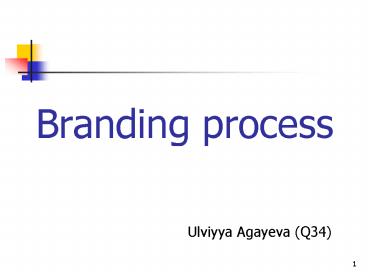Branding process - PowerPoint PPT Presentation
Title:
Branding process
Description:
Branding process Ulviyya Agayeva (Q34) What is a Brand? A brand is a name, term, sign, symbol, or design which is intended to identify the goods or services of one ... – PowerPoint PPT presentation
Number of Views:197
Avg rating:3.0/5.0
Title: Branding process
1
Branding process
- Ulviyya Agayeva (Q34)
2
What is a Brand?
- A brand is a name, term, sign, symbol, or design
which is intended to identify the goods or
services of one seller or group of sellers. - Global brands include Facebook, Apple, Pepsi,
McDonald's, Mastercard, Gap, Sony and Nike
3
Brand
- A brand can take many forms, including a name,
sign, symbol, color combination or slogan. For
example, Coca Cola is the name of a brand make by
a particular company. The word branding began
simply as a way to tell one person's cattle from
another by means of a hot iron stamp. The word
brand has continued to evolve to encompass
identity it affects the personality of a
product, company or service. It is defined by a
perception, good or bad, that your customers or
prospects have about you.
4
Brand elements
- Name The word or words used to identify the
company, product, service, concept - Logo The visual trademark that identifies the
brand - Tagline or Catchphrase "The Quicker Picker
Upper" is associated with Bounty "Can you hear
me now" is an important part of the Verizon
brand. - Shapes The distinctive shape of the Coca-Cola
bottle or the Volkswagen Beetle are trademarked
elements of those brands.
5
Brand elements
- Graphics The dynamic ribbon is also a
trademarked part of Coca-Cola's brand. - Color Owens-Corning is the only brand of
fiberglass insulation that can be pink. - Sounds A unique tune or set of notes can
"denote" a brand NBC's chimes are one of the
most famous examples. - Movement Lamborghini has trademarked the upward
motion of its car doors. - Smells Scents, such as the rose-jasmine-musk of
Chanel No. 5 is trademarked. - Taste KFC has trademarked its special recipe of
11 herbs and spices for fried chicken.
6
Basic Branding process and Steps
- Step 1 Problem
- Step 2 Information Search
- Step 3 Evaluation of Choices
7
Step 1 Problem
- What are the needs and wants?
- Before brand messages can influence customers or
prospects, brand messages must first get the
attention of these customers and prospects. - Selective perception is the process used to
decide what is worthy of attention.
8
Maslows Needs
9
Safety and Security Needs
- We often see marketers use the safety need of
Maslows Needs in automobile ads.
10
Social Needs-Example
11
Step 2 Information Search
- During the search for information, customers
usually focus on the differences they perceive
among competing brands. - Brand awareness and brand knowledge are crucial
here. - Research shows that when customers see marketing
communication that is relevant to them, they are
more likely to pay attention and think about it. - Two routes used in information searching
- Central Route
- Peripheral Route
12
Step 3 Evaluation of Choices Cognitive
Responses
- A cognitive response involves reasoning,
judgment, or knowledge. - Six risks both consumers and businesses try to
minimize - Financial risk
- Performance risk
- Physical risk
- Psychological risk
- Social risk
- Time-loss risk
13
The Key to Branding
- For branding strategies to be successful,
consumers must be convinced that there are
meaningful differences among brands in the
product or service category. - Consumer must not think that all brands in the
category are the same. - PERCEPTION VALUE
14
Strategic Brand Management
- Strategic brand management involves the design
and implementation of marketing programs and
activities to build, measure, and manage brand
equity. - The strategic brand management process is defined
as involving four main steps - 1) Identifying and establishing brand
positioning and values - 2) Planning and implementing brand marketing
programs - 3) Measuring and interpreting brand performance
- 4) Growing and sustaining brand equity
15
(No Transcript)
16
Brand Mantras
- A brand mantra is an articulation of the heart
and soul of the brand. - Brand mantras are short three to five word
phrases that capture the irrefutable essence or
spirit of the brand positioning and brand values.
- Nike
- Authentic Athletic Performance
- Disney
- Fun Family Entertainment
17
Keller Bes
- Be analytical Use frameworks of consumer
behavior and managerial decision-making to
develop well-reasoned communication programs - Be curious Fully understand consumers by using
all forms of research and always be thinking of
how you can create added value for consumers - Be single-minded Focus message on well-defined
target markets (less can be more) - Be integrative reinforce your message through
consistency and cuing across all communications
18
Keller Bes
- Be creative State your message in main
fashion use alternative promotions and media to
create favorable, strong - Be observant Monitor competition, customers,
channel members, and employees through tracking
studies - Be realistic Understand the complexities
involved in marketing communications - Be patient Take a long-term view of
communication effectiveness to build and manage
brand equity































